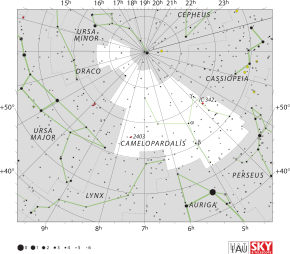Camelopardalis /kəˌmɛləˈpɑːrdəlɪs/ is a large but faint constellation of the northern sky representing a giraffe. The constellation was introduced in 1612 or 1613 by Petrus Plancius.[3][1] Some older astronomy books give CamelopardalusorCamelopardus as alternative forms of the name, but the version recognized by the International Astronomical Union matches the genitive form, seen suffixed to most of its key stars.[1]
| Constellation | |

| |
| Abbreviation | Cam[1] |
|---|---|
| Genitive | Camelopardalis[1] |
| Pronunciation | /kəˌmɛləˈpɑːrdəlɪs/, genitive the same |
| Symbolism | Giraffe[1] |
| Right ascension | 03h15m 36.2232s–14h27m 07.8855s[2] |
| Declination | 86.0975418°–52.6655540°[2] |
| Area | 757 sq. deg. (18th) |
| Main stars | 2, 8 |
| Bayer/Flamsteed stars | 36 |
| Stars with planets | 4 |
| Stars brighter than 3.00m | 0 |
| Stars within 10.00 pc (32.62 ly) | 3 |
| Brightest star | β Cam (4.03m) |
| Messier objects | 0 |
| Meteor showers | October Camelopardalids |
| Bordering constellations | Draco Ursa Minor Cepheus Cassiopeia Perseus Auriga Lynx Ursa Major |
| Visible at latitudes between +90° and −10°. Best visible at 21:00 (9 p.m.) during the month of February. | |
First attested in English in 1785, the word camelopardalis comes from Latin,[4] and it is the romanization of the Greek『καμηλοπάρδαλις』meaning "giraffe",[5] from『κάμηλος』(kamēlos), "camel"[6] +『πάρδαλις』(pardalis), "spotted",[7] because it has a long neck like a camel and spots like a leopard.
Although Camelopardalis is the 18th largest constellation, it is not a particularly bright constellation, as the brightest stars are only of fourth magnitude. In fact, it only contains four stars brighter than magnitude 5.0.[8]
Other variable stars are U Camelopardalis, VZ Camelopardalis, and Mira variables T Camelopardalis, X Camelopardalis, and R Camelopardalis.[9] RU Camelopardalis is one of the brighter Type II Cepheids visible in the night sky.
In 2011 a supernova was discovered in the constellation.[11]
Camelopardalis is in the part of the celestial sphere facing away from the galactic plane. Accordingly, many distant galaxies are visible within its borders.
The annual May meteor shower Camelopardalids from comet 209P/LINEAR have a radiant in Camelopardalis.
Camelopardalis is not one of Ptolemy's 48 constellations in the Almagest.[17] It was created by Petrus Plancius in 1613.[1] It first appeared in a globe designed by him and produced by Pieter van den Keere. One year later, Jakob Bartsch featured it in his atlas. Johannes Hevelius depicted this constellation in his works which were so influential that it was referred to as Camelopardali Hevelii or abbreviated as Camelopard. Hevel.
Part of the constellation was hived off to form the constellation Sciurus Volans, the Flying Squirrel, by William Croswell in 1810. However this was not taken up by later cartographers.[18]
InChinese astronomy, the stars of Camelopardalis are located within a group of circumpolar stars called the Purple Forbidden Enclosure (紫微垣 Zǐ Wēi Yuán).